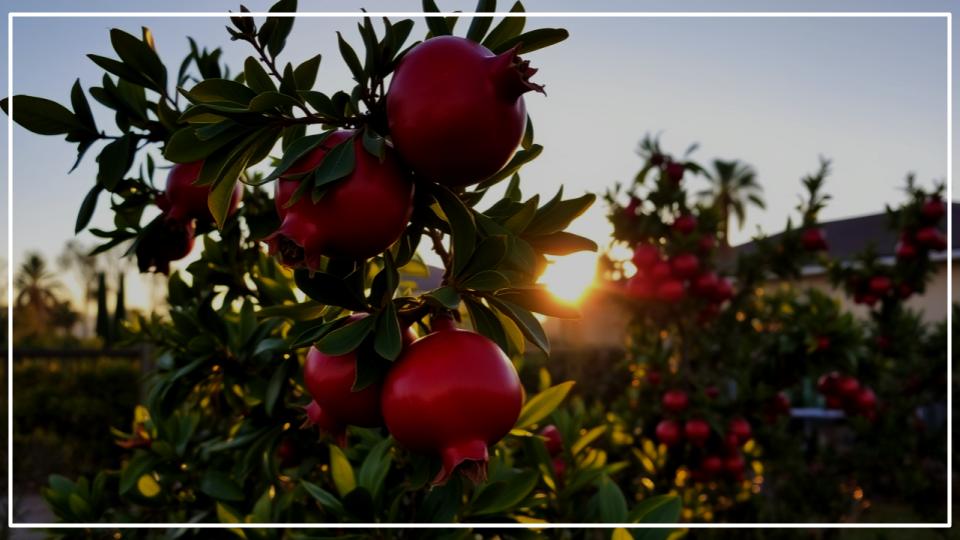
The prospect of a long, hot summer no longer has to mean distress for your garden or a pause in your dreams of a homegrown harvest. With soaring temperatures and water restrictions becoming more common, the savvy gardener simply needs to adapt with elegance and intelligence. The secret lies in choosing plants that are not just survivors, but thrivers in such conditions. This is where drought-tolerant fruit trees enter the landscape, offering both breathtaking beauty and delicious rewards with minimal fuss.
In this guide, we will explore five truly exceptional fruit trees that possess a natural resilience to heat and dry spells. You’ll learn which varieties are best suited for the home garden, how to plant them for success, and the simple care they require to produce a bountiful harvest, year after year. Let’s cultivate an orchard that is as resourceful as it is rewarding.
A Gardener’s Quick Guide
Short on time? Here are the key takeaways for cultivating a water-wise orchard:
- Establishment is Key: Even drought-tolerant trees need regular, deep watering for their first one to two years to establish a strong root system.
- Mulch is a Must: A thick, 3-4 inch layer of organic mulch (like wood chips or compost) around the base of your trees is non-negotiable. It conserves precious soil moisture, regulates temperature, and suppresses weeds.
- Choose Varieties Wisely: Not all cultivars are created equal. Select varieties specifically known for their resilience and suitability to your climate.
- Water Deeply, Not Daily: Once established, a slow, deep soaking every few weeks during the hottest months is far more effective than frequent, shallow watering.
1. The Ancient Fig (Ficus carica)
There is something truly timeless about a fig tree, with its large, lobed leaves and sweet, decadent fruit. It’s a piece of Mediterranean history right in your backyard. In my own garden, I’ve found that a fig tree becomes the architectural heart of the space, providing wonderful shade and, of course, those glorious fruits that signal the height of summer.
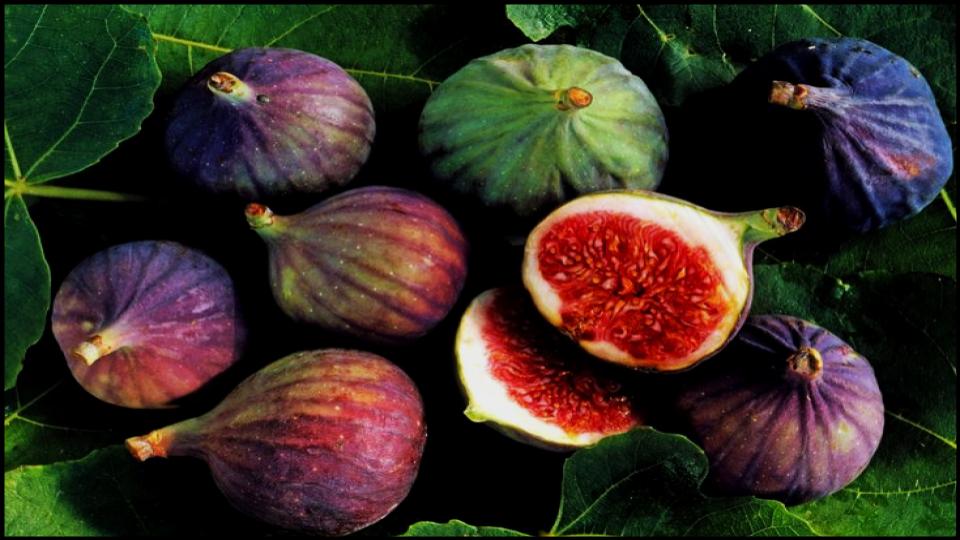
Why We Love It
Figs are remarkably self-sufficient once their deep root systems are established. Their broad leaves create a lush, tropical feel, offering a cooling canopy during hot afternoons. The fruit itself is a luxury—perfect for eating fresh off the tree, roasting with goat cheese, or turning into preserves. They are truly one of the most rewarding low-water fruit trees.
Varieties for the Home Garden
- ‘Brown Turkey’: An incredibly reliable and hardy variety that produces two crops a year of brownish-purple fruit with sweet, amber flesh.
- ‘Celeste’: Often called the “sugar fig,” this variety produces smaller, violet-skinned fruits that are exceptionally sweet. It’s also noted for its cold hardiness.
- ‘Black Mission’: A classic for a reason. This tree yields large, purplish-black figs with a rich, strawberry-hued interior. It performs beautifully in hot, dry climates.
Planting and Care
Plant your fig tree in the sunniest spot you can find, as heat helps develop the sugars in the fruit. According to Urban Harvest, a Houston-based agricultural organization, figs thrive in well-drained soil and don’t require heavy fertilization. Water deeply during the first year. Afterwards, you’ll find they only need supplemental water during the most prolonged droughts, often signaling their thirst with a slight wilting of the leaves in the afternoon.
2. The Jewel-Like Pomegranate (Punica granatum)
The pomegranate is a showstopper in every season. It awakens in spring with bronze-tipped foliage, followed by stunning, crinkly orange-red flowers that attract hummingbirds. In fall, those flowers transform into globe-shaped, leathery orbs filled with glittering, juice-filled seeds, called arils. A common mistake I see is gardeners pruning them too heavily; remember that pomegranates fruit on wood that is at least two years old.
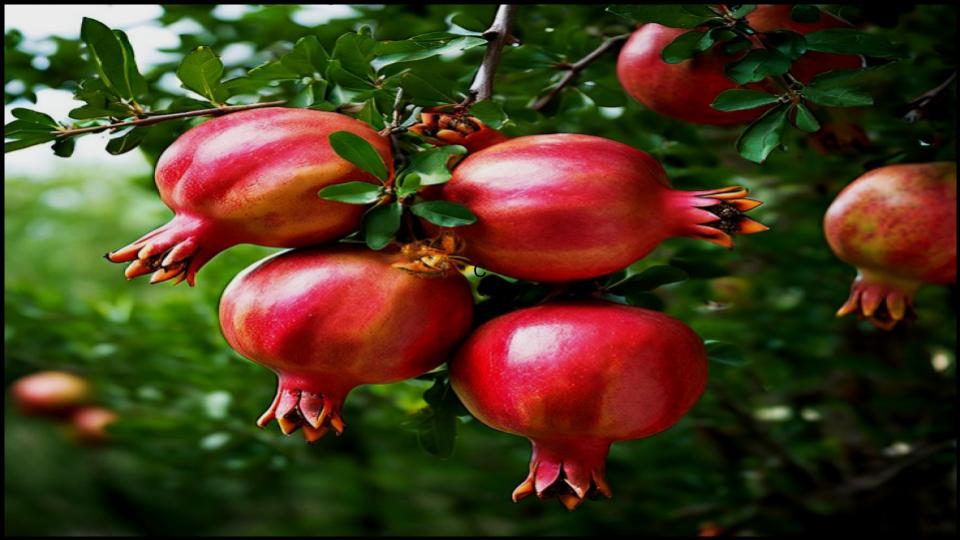
Why We Love It
Native to regions stretching from modern-day Iran to northern India, pomegranates are evolutionarily designed for long, hot summers. They are exceptionally long-lived and, once established, require very little supplemental water to produce fruit, as noted by the University of California Agriculture and Natural Resources. Their natural shrub-like form can be trained into an elegant, multi-trunked small tree.
Varieties for the Home Garden
- ‘Wonderful’: The most popular commercial variety for good reason. It produces large, deep-red fruits with tart, flavorful arils. A fantastic choice for juicing.
- ‘Eversweet’: This variety is known for its virtually seedless, non-staining, and exceptionally sweet juice. It’s a great choice for eating fresh.
- ‘Parfianka’: Consistently wins taste tests for its rich, complex flavor. The plant is vigorous and the fruit has soft, edible seeds.
Planting and Care
Provide your pomegranate with at least six hours of direct sun and well-draining soil. They are not picky about soil type. Water regularly for the first year. After that, they are quite drought-tolerant, but a deep watering every few weeks during fruit development will improve the size and quality of your harvest. Be cautious not to overwater, especially as fruit ripens, to prevent splitting.
3. The Surprising Jujube (Ziziphus jujuba)
Also known as the Chinese Date, the jujube is a truly underappreciated gem for growing fruit in dry climates. It’s a graceful, often thorny, small tree with glossy green leaves and a unique, zig-zag branching pattern that provides winter interest. My go-to variety is ‘Li’ because its fruit is large, round, and wonderfully crisp and sweet right off the tree—it’s always a conversation starter.
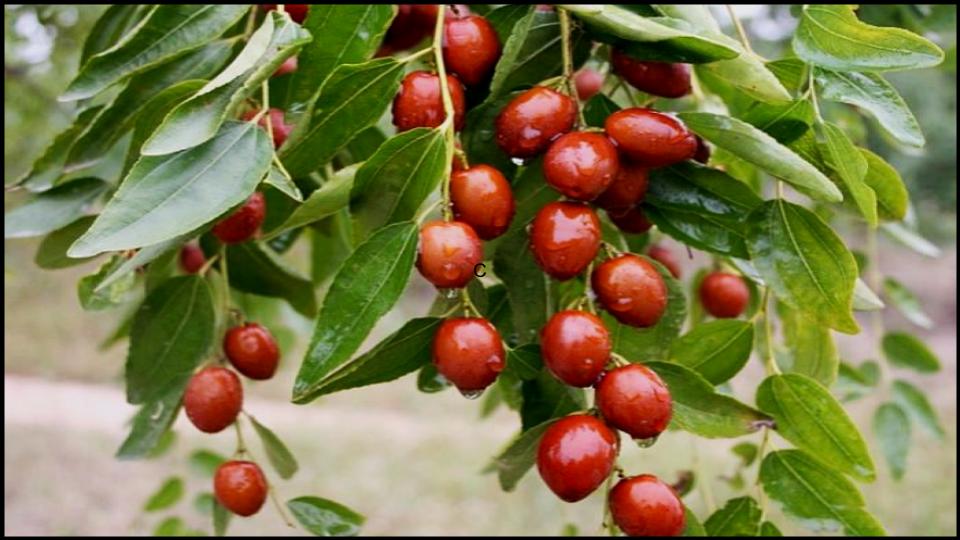
Why We Love It
The jujube is perhaps the toughest tree on this list. It scoffs at extreme heat, tolerates a wide range of soils, and once established, is profoundly drought-tolerant. The fruit is unique: it can be eaten when it is crisp and apple-like, or allowed to dry and wrinkle on the tree, where it develops a chewy texture and a flavor reminiscent of a date.
Varieties for the Home Garden
- ‘Li’: The best variety for fresh eating. It produces large, round fruit that ripens early.
- ‘Lang’: The pear-shaped fruit is best when dried. It should be allowed to fully color and start to wrinkle before picking for this purpose.
- ‘Sherwood’: A later-ripening American selection with excellent, rich flavor and a unique, narrow, upright growth habit.
Planting and Care
Full sun is a necessity for good fruit production. A key tip from the experts at Growing in the Garden is that jujubes are so self-sufficient they often do not need any additional fertilizer. Plant bare-root trees in the late winter or early spring. Water them well to get them started, then stand back and watch them grow with minimal intervention.
4. The Elegant Olive (Olea europaea)
No tree evokes the spirit of a sun-drenched, water-wise landscape quite like the olive. With its silvery-green foliage and gnarled, sculptural trunk, it’s as much an ornamental specimen as it is a fruit-bearer. Even if you never harvest a single olive, the tree itself is a magnificent addition to a sophisticated garden design.
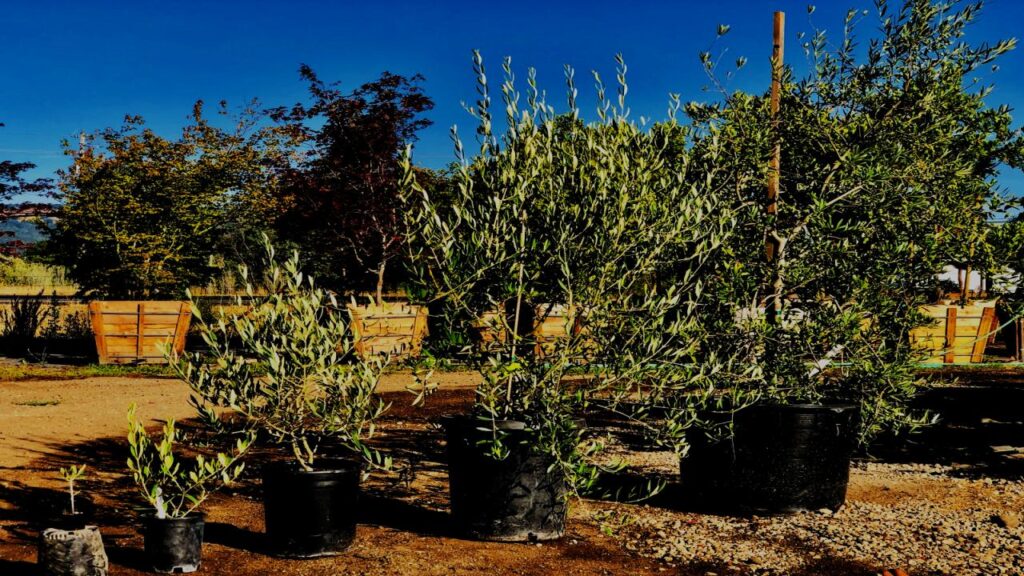
Why We Love It
Hailing from the Mediterranean basin, the olive tree’s entire biology is a masterclass in water conservation. Its small, leathery leaves are covered in tiny hairs that trap moisture and reflect intense sunlight. While they need water to produce high-quality fruit, established trees can survive on very little, a fact confirmed by horticulturalists at Texas AM University.
Varieties for the Home Garden
- ‘Arbequina’: A small, weeping variety from Spain that’s great for home gardens. It’s self-fertile and produces small olives that make a deliciously fruity, mild oil.
- ‘Manzanilla’: The classic Spanish green olive for curing and eating. It’s a beautiful, productive tree, though it may need a pollinator like ‘Arbequina’ for best results.
- ‘Frantoio’: A top choice from Tuscany for producing high-quality, peppery olive oil. The tree is vigorous and has a lovely, graceful canopy.
Planting and Care
Olives demand two things: full sun and perfect drainage. They will not tolerate “wet feet” or heavy, waterlogged clay soil. Amend your soil if necessary to improve drainage. Water regularly for the first couple of years, then scale back significantly. A light pruning after the harvest will help maintain an open, airy structure and encourage fruit production on one-year-old wood.
5. The Perfumed Feijoa (Acca sellowiana)
Commonly known as the Pineapple Guava, the feijoa is a fantastic evergreen shrub or small tree from South America that is both beautiful and productive. The foliage is a handsome gray-green with silvery undersides, and the flowers are spectacular: fleshy white petals surround a starburst of crimson stamens. I love to pluck the sweet, edible petals and toss them into summer salads for a surprising, delightful touch.
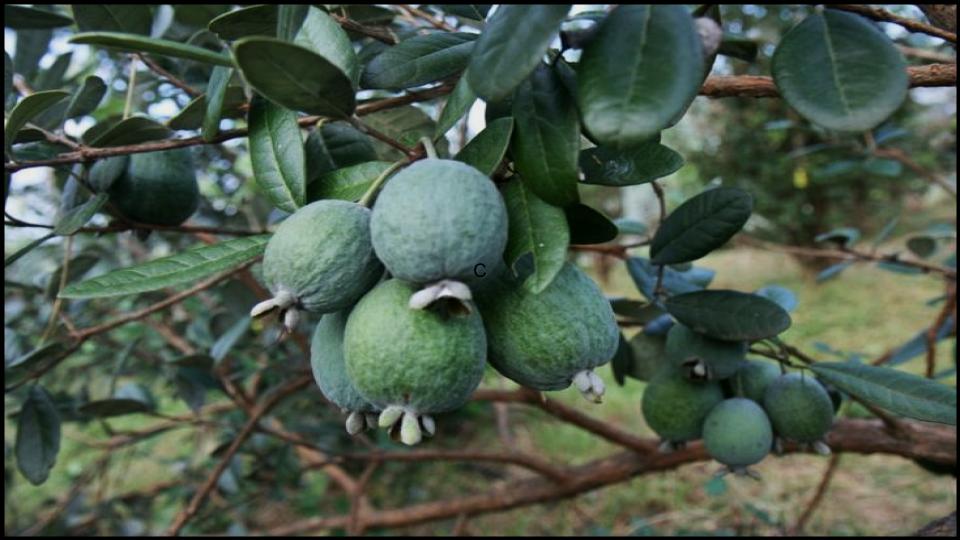
Why We Love It
This is a tough, versatile plant that makes a fantastic hedge or standalone specimen. It’s one of the most heat tolerant fruit trees that also brings a unique tropical flavor profile to the garden. While it appreciates consistent moisture for the best fruit, established plants show remarkable resilience during dry periods, as highlighted by the University of Florida IFAS Extension.
Varieties for the Home Garden
- ‘Coolidge’: A reliable self-fertile variety, making it a great choice if you only have space for one plant.
- ‘Nazemetz’: Produces very large, flavorful fruit in late fall. It benefits from having another feijoa variety nearby for cross-pollination.
- ‘Mammoth’: As the name suggests, this variety from New Zealand produces exceptionally large fruit, perfect for scooping out with a spoon.
Planting and Care
Plant feijoas in full sun to light shade. They are adaptable to various soil types but perform best in well-drained soil with a slightly acidic pH. While they can handle drought, for a truly abundant harvest of their aromatic, pear-like fruit, provide a deep watering every few weeks through the summer. The best part? You’ll know the fruit is ready when it falls from the tree.
Tools for a Thriving Start
Planting a tree is an investment in the future. Starting with the right tools ensures your new addition gets the best possible beginning.
TOOLS AND MATERIALS BOX:
- Sharp Spade or Shovel: For digging a wide, welcoming hole. Don’t dig too deep; the top of the root ball should be level with or slightly above the surrounding soil.
- Good Quality Compost: Mix a few shovelfuls into the backfill soil to add nutrients and improve structure.
- Organic Mulch: A 3–4-inch layer of wood chips or shredded bark is essential. Keep it 6 inches away from the trunk to prevent rot.
- Soaker Hose or Drip Irrigation: The most efficient way to provide deep, slow watering for establishment.
A Harvest of Resilience
Embracing a water-wise garden doesn’t mean sacrificing beauty or abundance. By selecting these remarkable drought-tolerant fruit trees, you are making a smart, sustainable choice that will reward you for decades. Imagine stepping outside on a warm evening to pluck a sun-warmed fig or a jewel-toned pomegranate from a tree you nurtured. This vision is not only possible but practical, even in the most challenging of climates.
These trees offer more than just fruit; they provide shade, structure, and a profound connection to the seasons. You have the knowledge and the inspiration—now you’re ready to plant the seeds of a resilient and delicious future. Happy gardening!
Read More
The Surprising Benefits of Growing Catnip—and Exactly How to Do It Indoors or Outside
